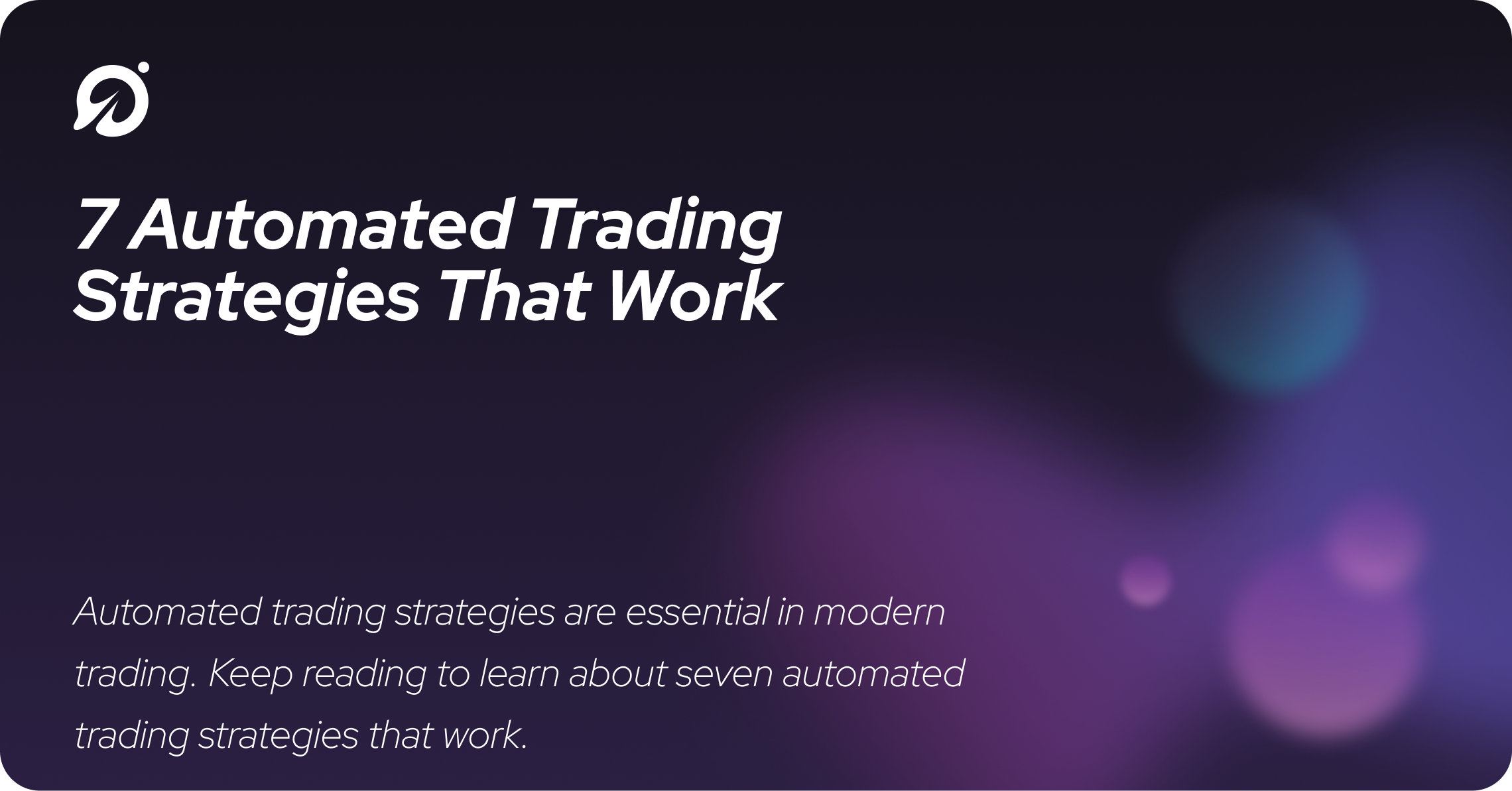7 Automated Trading Strategies That Work
Automated trading, also known as algorithmic trading, is a trading strategy using software to place trades on your behalf automatically. Often, automated trading strategies are trained using historical data to spot market trends.

What Is Automated Trading?
There are many kinds of automated trading strategies. Most use a combination of technical indicators to create a set of instructions for the system to trade based on.
Automated trading has become increasingly popular in equities due to increased access to financial data and improved computing.
Here are seven automated trading strategies that work with crypto, as well as how you can get started with our platform today.
1. Time-Series Mean Reversion
What Is Time-Series Mean Reversion?
Time-series mean reversion is when an asset corrects over time to a mean price over that period. If the price exceeds the mean, it tends to drift toward that average. If the price is below the mean, it tends to drift up.
You can also use different moving averages as anchor points for mean reversion strategies. A basic mean reversion system picks an indicator that smoothes price over time and trades when the market price is out of line.
How To Use Time-Series Mean Reversion
To use Time-Series Mean Reversion to trade, you need to determine if the asset is mean-reverting. You can backtest any crypto for mean reversion using Pluto’s free backtesting tools. Just sign in with your email and start testing today.
Once you determine an asset is mean-reverting. You can create an automated strategy that buys when the price is below the mean and sells when it’s above the mean.
The time interval is a variable often tweaked in time-series mean reversion trading strategy.
Using backtesting, you can decide which interval to trade given market conditions. Does the asset revert toward the weekly mean or hourly during a bull market?
You may want to change the indicator on which you base your strategy. Exponential moving averages (EMAs), weighted moving averages (WMAs), and simple moving averages (SMAs) are all popular indicators to use. These are common in all financial markets, not just crypto.
Weighted averages are used across 10, 20, 50, 100, and 200-day periods. Shorter time frames are used for short-term trades. For example, the 20-day EMA is the exponential moving average of the last 20 trading days.
Using Pluto’s backtesting tools, you can tweak the period of every indicator used in a given strategy to find patterns.
2. Cross-Sectional Mean Reversion
What Is Cross-Sectional Mean Reversion?
A cross-sectional mean reversion strategy is when you calculate how a specific asset's mean reversion compares to all the other assets in its asset class or, more broadly, to all assets.
Our guide to arbitrage trading provides further information on broad strategies that compare many assets.
How Do You Use Cross-Sectional Mean Reversion?
Assets that are outperforming the market have positive relative returns. And assets that are underperforming in the market have negative relative returns.
If you short all assets with a positive relative return and long all assets with a negative relative return, you may profit over a long enough period.
Cross-Sectional mean reversion is a way to find market laggards and automatically capitalize off their mean reversion. Using Pluto, you can filter for factors like volume and volatility that might increase mean reversion quickly.
3. Dollar Cost Averaging
What Is Dollar Cost Averaging?
Dollar cost averaging is a strategy that implements repeated, price-agnostic buys over given intervals. The idea is to smooth out your cost basis over time and take the emotion out of your investments.
How To Use Dollar Cost Averaging
Because DCA-ing isn’t a complex automated strategy, you can schedule purchases manually every week or month that you’re DCA-ing.
Most cryptocurrency exchanges like Coinbase or Binance offer recurring buys to investors looking to DCA automatically. This can be handy for buying crypto with each paycheck.
In more complex strategies, you can take profits in Bitcoin, Ethereum, or another long-term investment. You can use automation to DCA a percentage of profits over time.
To learn more about DCA, check out our guide to crypto acronyms.
4. Day Trading Automation
What Is Day Trading Automation?
Day trading is someone who opens and closes multiple trades in one day. A rule of thumb is more than three trades a day on average.
Day traders or LTF (low time frequency) traders use short-term indicators and trade setups to make profits quickly.
Many day traders trade a calendar of events like Fed meetings, earnings, and holidays to make quick directional bets. A profitable trading bot can automatically trade these events on behalf of human traders.
Forex traders are known to use automated trading systems to execute their daily trades for them using various software options.
How Do You Use Day Trading Automation?
Using Pluto's trading platform, you can use automation to make intraday trades on your behalf. Watch our primer video to learn how.
Or you can develop your trading script in python and connect it to the exchange or brokerage of your choice using an API. Other programming languages can be used, but a wealth of existing open-source trading libraries are built for python.
5. Arbitrage
What Is Arbitrage?
An arbitrage opportunity is when price discrepancies between prices of the same asset across markets. For example, Bitcoin trading for $17,000 on Coinbase and $17,050 on Binance is an arbitrage opportunity.
In a nutshell, the market pays traders to find and correct pricing inefficiencies. Algorithmic traders use bots to identify and capitalize on various arbitrage strategies.
One popular strategy is statistical arbitrage. Statistical arbitrage uses mathematical models similar to cross-sectional mean reversion. The model looks for exchanges or markets where assets are mispriced relative to the rest of the market.
How Do You Use Arbitrage?
To use arbitrage to profit, you must first find assets that are mispriced across markets. Then you buy the cryptocurrency for the lower price, move it to the market with the higher price, and then sell it.
Finding arbitrage opportunities can be time-consuming and futile as trading bots capture most arbitrage. You can use automated trading strategies to find arbitrage and execute trades automatically on your behalf.
There’s no free lunch in crypto trading, however. Your arbitrage bot will need some edge over the market, like computation speed or specialized indicators, to win the race to arbitrage trades.
6. Time Weighted Average Price (TWAP)
What Is TWAP?
TWAP is an automated trade execution that attempts to achieve an average trade price close to the time-weighted average price over a predetermined period.
Most of the time, it isn’t optimal to buy or sell a significant position all at once. TWAP systems increase the optimization of large trades by mathematically getting you the best possible price over some time.
How Do You Use TWAP?
TWAP is used by hedge funds and other large entities to execute a large order without moving the market. Large market makers can be disadvantaged when unloading or building significant positions.
“Twapping” can help them quietly make trades without tipping off other market participants.
For example, a fund trying to unload $1 million of tokens might crash the price and hurt their trade by selling all of the tokens at once.
Using TWAP to exit their position, they won’t crash the price and may receive a better average sale price over time.
7. Volume Weighted Average Price (VWAP)
What Is VWAP?
VWAP is a trading indicator that represents daily average price factoring for volume. VWAP is calculated over daily or weekly intervals by adding the price of all trades and dividing by the number of trades.
How Do You Use VWAP?
A trader can use VWAP to determine if they’re getting a reasonable price on a crypto asset. In an automated trading strategy, you might buy when the price is below the daily VWAP and sell when it’s above.
Like all indicators, VWAP isn’t a silver bullet but a checkbox to consider before making a trade. VWAP can also determine TWAP price when unwinding a considerable position.
Using Pluto's free trading tools, you can build an automated strategy that takes multiple indicators into account.
What Are the Benefits of Automated Trading?
Algorithmic trading strategies take the emotion out of trading. These strategies allow you to focus on long-term trends and patterns without worrying about checking crypto prices.
Algo trading can outperform human traders, who tend to make mistakes and base trade decisions on emotion.
Automated trading systems are customizable. You can even calibrate them to make different trades based on market conditions.
Using an algorithmic trading system is great for risk management. You can program in adaptable stop losses to protect against severe drawdowns.
Remember that by using an automated strategy, you are trusting your trading account to a chunk of code. You always need to set appropriate risk reduction parameters.
The Bottom Line
There are a million different ways to configure an automated trading system. Basic strategies like mean reversions, dollar cost averaging, and VWAP can be combined to create robust trading systems.
With the advent of machine learning, more and more traders will likely rely on AI to develop their trading software. However, trading algorithms will always need a human trader to tweak parameters as markets change.
You will need to crunch many numbers to find profitable automated trading strategies. Join Pluto today to get access to our free backtesting tools. You’ll be on your way to creating a market-beating automated strategy.
Sources:
Binance what is TWAP | Binance
Volume-Weighted Average Price (VWAP): Definition and Calculation | Investopedia
